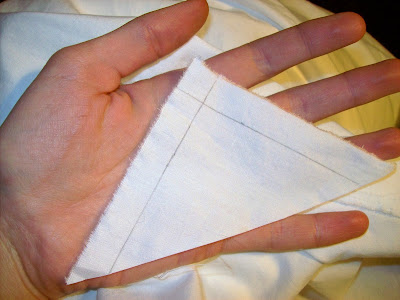Annie's Tunic
Not all of my sewing is historic in nature. I enjoy making
modern garments, household items, decorative accessories, and more. Here are
some photos of a comfortable cotton tunic I made for my friend Annie. We saw a
similar garment in a boutique; she loved it, so I decided to surprise her by
making one. I chose the fabric because it looked like a painting that Annie had
made that was hanging in her kitchen. The fabric is 100% cotton, but I realized
afterward that a better choice would be cotton gauze or something similarly
thin, cool, and with more relaxed drape. I later made another tunic out of
cotton gauze and a third out of a very drapey rayon scarf, both requested from
my friends after they saw this one. It sure is delightful to sew for other
people!
The pattern of this garment is very simple. First, I made a rectangle large enough to fit comfortably without being a tent and long enough to hang to above the knee. Next, I roll-hemmed all four edges. Then, I cut a neck hole in the center. A deep V-neck is best. This red tunic’s neckline is finished with a narrow hand-rolled edge, but a better and more durable option is to face the neckline with something sturdy such as cotton bias tape, which is what I did for the next tunics I made. The next step is to sew side seams about four inches in from the sides. These seams should be simple straight lines starting a few inches from the bottom edge and ending a few inches below the armpit.
After that, I made a casing for a drawstring. I used self-made straight-grain tape, but pre-made bias tape or any similar option would work. I pinned the casing on the front outside of the tunic, running from side seam to side seam, but the casing could also be on the inside of the garment. I sewed along the top edge of the casing, hand-sewed two eyelets at the center front, inserted a self-fabric drawstring (you can also use ribbon, cording, or twill tape), and then sewed along the bottom edge of the casing. The back waistline is formed by elastic, but the next tunics I made instead had a drawstring casing running all around the waistline on the inside. This option is more adjustable and comfortable.
This tunic design is so simple and makes an ideal nightdress or even a snazzy fashion item worn with jeans. It is a great way to showcase a beautiful fabric and an ideal gift as the fit does not have to be customized. I truly enjoyed making these tunics; it is fun to have a project that does not take much time or effort but is still handmade and displays good workmanship.
The pattern of this garment is very simple. First, I made a rectangle large enough to fit comfortably without being a tent and long enough to hang to above the knee. Next, I roll-hemmed all four edges. Then, I cut a neck hole in the center. A deep V-neck is best. This red tunic’s neckline is finished with a narrow hand-rolled edge, but a better and more durable option is to face the neckline with something sturdy such as cotton bias tape, which is what I did for the next tunics I made. The next step is to sew side seams about four inches in from the sides. These seams should be simple straight lines starting a few inches from the bottom edge and ending a few inches below the armpit.
After that, I made a casing for a drawstring. I used self-made straight-grain tape, but pre-made bias tape or any similar option would work. I pinned the casing on the front outside of the tunic, running from side seam to side seam, but the casing could also be on the inside of the garment. I sewed along the top edge of the casing, hand-sewed two eyelets at the center front, inserted a self-fabric drawstring (you can also use ribbon, cording, or twill tape), and then sewed along the bottom edge of the casing. The back waistline is formed by elastic, but the next tunics I made instead had a drawstring casing running all around the waistline on the inside. This option is more adjustable and comfortable.
 |
| Obligatory cat photo |
This tunic design is so simple and makes an ideal nightdress or even a snazzy fashion item worn with jeans. It is a great way to showcase a beautiful fabric and an ideal gift as the fit does not have to be customized. I truly enjoyed making these tunics; it is fun to have a project that does not take much time or effort but is still handmade and displays good workmanship.





Comments
Post a Comment